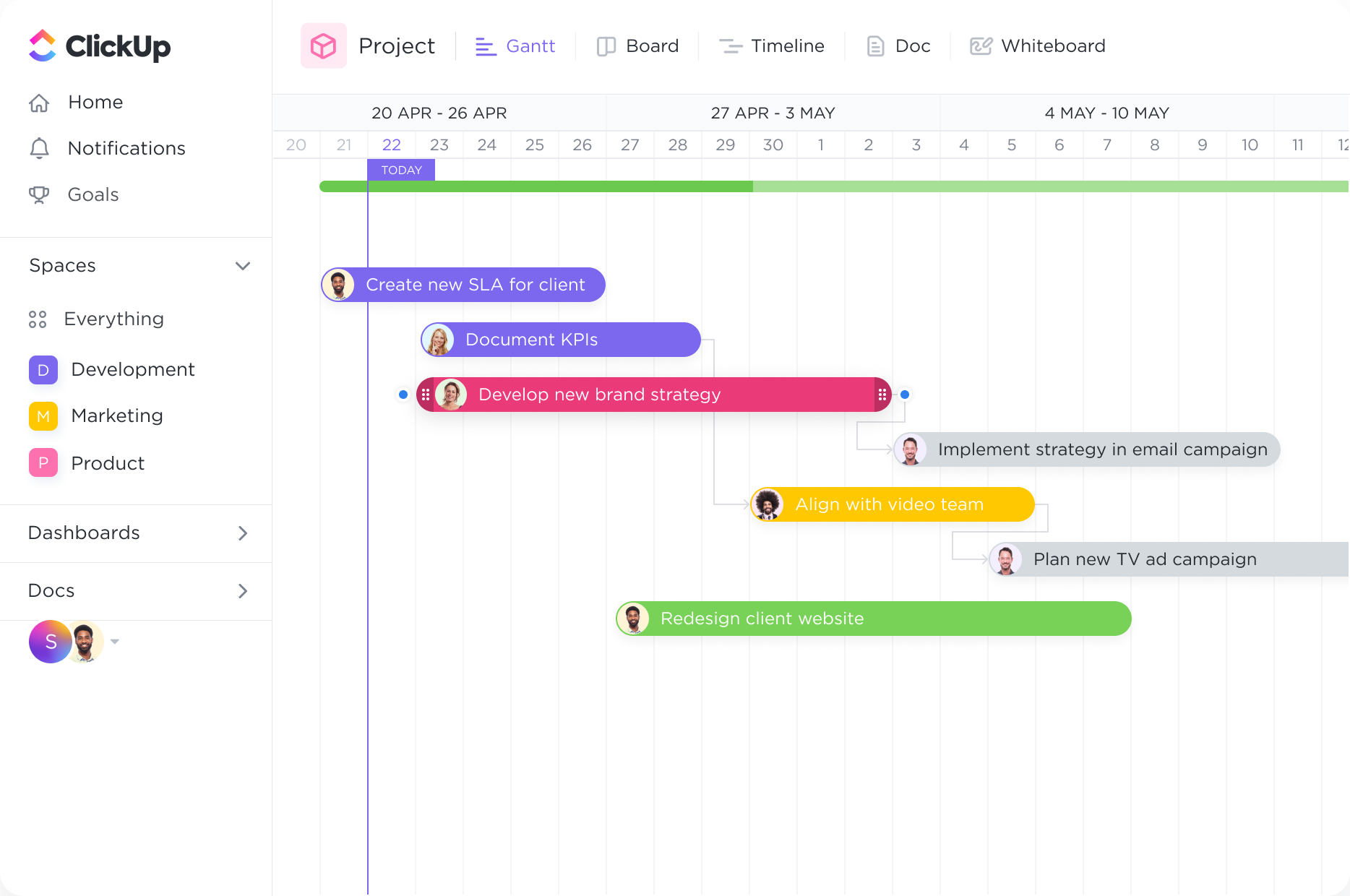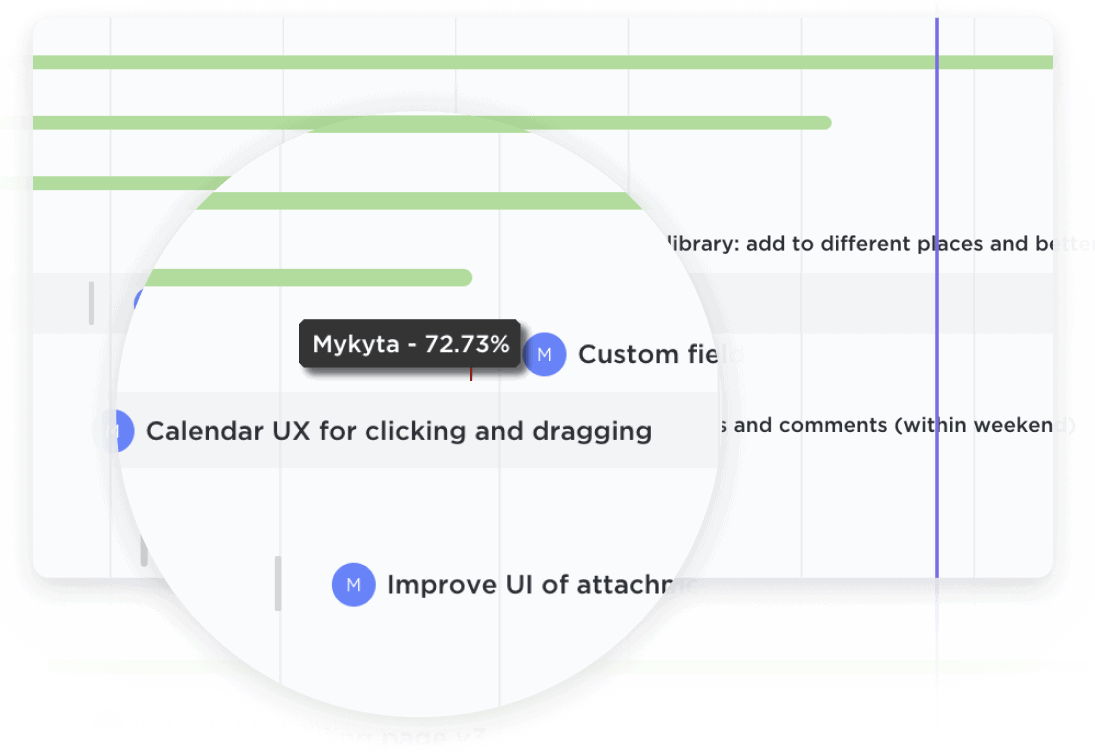Visualize
Organize and set priorities.
Organize how you see your tasks with quick sorting. Create cascading views with a single click to easily see what important tasks are coming next.
Gantt Charts
Streamline your importing processes with ClickUp's Gantt Chart software. Visualize and manage every step of your import projects using a user-friendly interface. Plan, schedule, and track tasks effortlessly to ensure a seamless and efficient importation process. Take control of your importing projects with ClickUp's Gantt Chart software and experience the ease and effectiveness of tailored project management.
Free forever. No credit card.

Visualize
Organize how you see your tasks with quick sorting. Create cascading views with a single click to easily see what important tasks are coming next.
Activity
Easily update projects with a simple drag-and-drop action to collaborate amongst your team in real-time. Dynamic progress percentages provide a detailed snapshot.

Importers often deal with complex supply chains and logistics processes. A Gantt chart can be used to plan and visualize the entire import process, including tasks such as sourcing suppliers, arranging transportation, managing customs clearance, and coordinating delivery. This helps importers stay organized, track progress, and ensure timely and efficient import operations.
Importers need to manage their inventory effectively to ensure they have sufficient stock to meet customer demand while minimizing carrying costs. A Gantt chart can be used to track inventory levels, monitor reorder points, and plan for replenishment. By visualizing inventory levels and reorder dates, importers can optimize their inventory management and avoid stockouts or excess inventory.
Importers rely on suppliers to provide high-quality products and timely deliveries. A Gantt chart can be used to track supplier performance, evaluate their reliability, and manage relationships. Importers can use the chart to monitor supplier lead times, track on-time deliveries, and identify any issues or delays. This helps importers make informed decisions about their suppliers and take necessary actions to maintain a smooth supply chain.
Ensuring the quality of imported products is crucial for importers. A Gantt chart can be used to schedule and track quality control inspections at various stages of the import process, such as pre-shipment inspections or factory audits. By visualizing the inspection schedule and progress, importers can identify any quality issues early on and take corrective actions, minimizing the risk of receiving substandard products.
Importers need to comply with various regulations and documentation requirements when importing goods. A Gantt chart can be used to track and manage the necessary documentation, such as import licenses, customs declarations, and certificates of origin. By visualizing the documentation process and setting deadlines, importers can ensure compliance and avoid any legal or regulatory issues.
Importers need to carefully plan and manage their finances to ensure profitability and avoid cash flow problems. A Gantt chart can be used to track and manage import-related expenses, such as product costs, transportation fees, customs duties, and other charges. By visualizing the financial aspects of the import process, importers can make informed decisions, allocate resources effectively, and stay within budget.
A Gantt chart can be used to create a timeline for each import project, including tasks such as sourcing suppliers, arranging transportation, customs clearance, and delivery. This helps importers visualize and manage the overall schedule.
Importers can use a Gantt chart to assign and track tasks with their suppliers and logistics providers, ensuring that everyone is aware of their responsibilities and deadlines.
By using a Gantt chart, importers can plan and monitor inventory levels based on their import schedules. This helps them avoid stockouts or overstock situations by aligning import timelines with sales forecasts.
With a Gantt chart, importers can easily identify any delays or bottlenecks in the import process, such as delays in customs clearance or transportation issues. This allows them to take proactive measures to mitigate these risks and keep the import process on track.
Importers can share Gantt charts with their stakeholders, such as suppliers, customers, and internal teams, to provide a visual representation of the import schedule and progress. This enhances communication and ensures that everyone is on the same page regarding timelines and expectations.
By analyzing the data in a Gantt chart, importers can identify areas for improvement in their import processes. They can evaluate the duration of each task, identify dependencies, and optimize the sequence of tasks to streamline the overall import process.
Gantt chart software can help importers streamline their supply chain processes by providing a visual representation of the entire supply chain, from order placement to delivery. It allows importers to track and manage key milestones, such as production, shipping, and customs clearance, ensuring that each step is completed on time. By identifying potential bottlenecks and delays, importers can proactively address issues and optimize their supply chain to improve efficiency and reduce costs.
Importers should look for Gantt chart software that offers features such as task management, resource allocation, timeline visualization, dependency tracking, and collaboration tools. Additionally, the software should have the ability to integrate with other project management tools, provide real-time updates, and offer customizable reporting options to enhance import planning and execution.
Yes, Gantt chart software can be integrated with other important management tools and systems, such as project management software, task management tools, and resource management systems. This integration allows for seamless data transfer, real-time updates, and enhanced collaboration among different platforms, improving overall project efficiency and coordination.